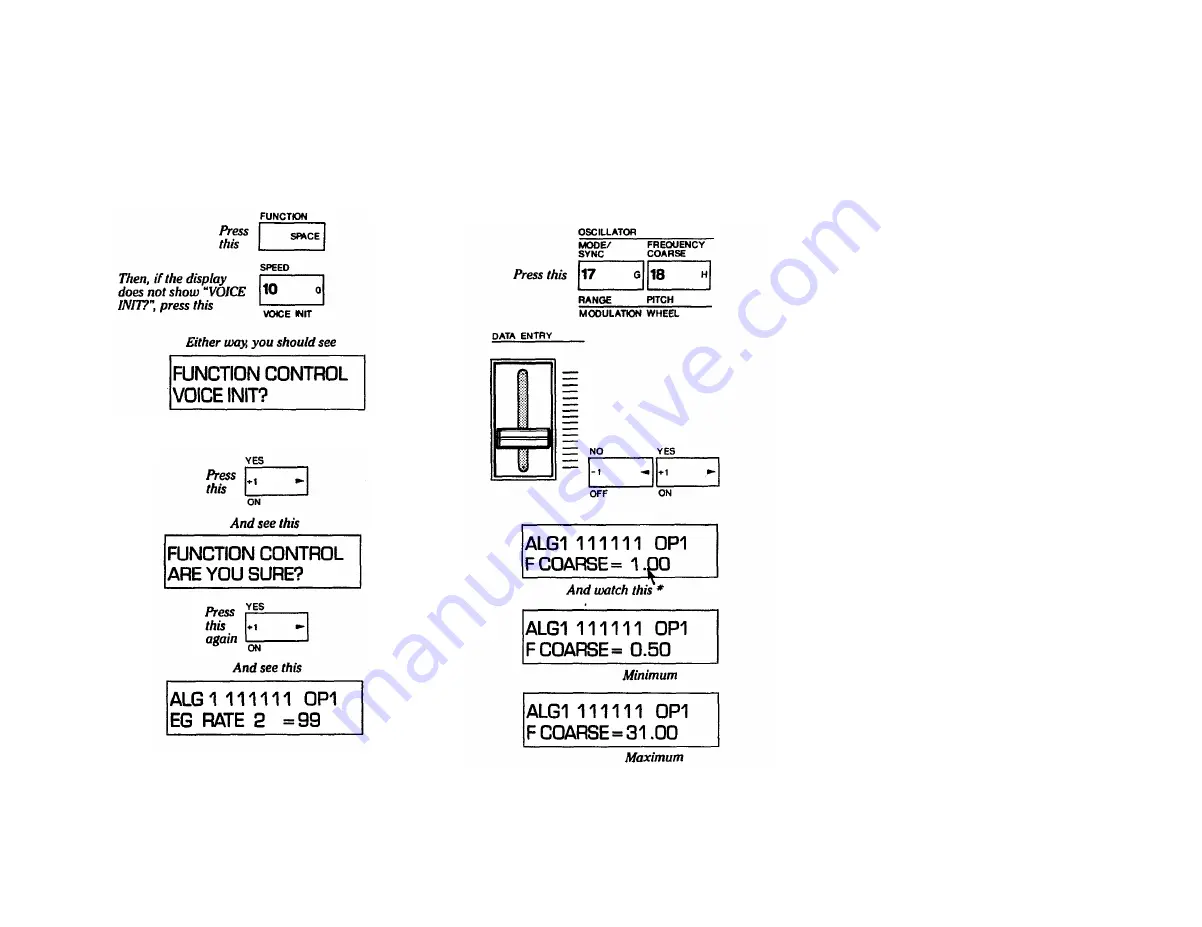
Instea d of taking the time to reprogram the envelope ,
we ask you to again use the Voice Initialize feature.. . it
save s time .
1. To gai n acces s to the "Voice Initialize " function , press
[FUNCTION], and then [VOICE INIT], and answer
the displayed prompts .
2. Then press [YES] twice to initialize the edit memory
(buffer).
The display shows "EG RATE 2 = 99 " for two rea -
sons. First , the programming paramete r displayed is
whateve r paramete r you had last adjusted . In this
case , going back to Ste p 6 of the previous instructions ,
you had set Rate 2 a t 50 , so "RAT E 2" is diplayed . The
value , however , is not 50 , bu t is 99 , since , a s you
know , the "initialized" envelop e has all rates a t 99 .
Play a note an d you'l l hea r the DX7 is back to the
"square " envelope .
3. Now pres s [OSCILLATOR-FREQUENCY COARSE ]
and operat e the [DATA ENTRY] slide r and/o r but -
ton s while playin g a note . Watch the display a s you
listen to the pitch change.
Then use the slider and/or
these buttons while continuing
to play Middle C
32
CAUTION Don't turn up the volume too high
or hold a note very long at the higher fre-
quency ratios or you can easily damage the
high frequency driver (tweeter) in your
speaker system. There's nothing "wrong" with
the synthesizer for "letting you" program such
high frequencies. The very high frequencies
are useful at low levels as part of a voice, or
for modulating with other frequencies in order
to produce lower frequencies that
are clearly
audible. Unless you're programming dog whis-
tles or ultrasonic alarm simulations,
you
won't ever use a ratio near 31.00 as a funda-
mental pitch tor a carrier.
NOTE The pitches you hear as you move the [DATA
ENTRY ] slider constitute the Harmonic Series of the
note you are playing. When the diplay indicates "F
COARSE= 1.00" the "1.00" part is the frequency ratio.
The "FCOARSE" part merely tells you that the adjust-
ments you make will be coarse. With the exception of
the "0.50" ratio, all COARSE adjustments are integer
multiples of the fundamental frequency of the note.
That is. "1.00" is the fundamental, "2.00" is 2 times
the fundamental frequency and so forth. If you play a
middle C, "1.00" is 262 Hz, "0.50" is 131 Hz (262 x
0.5), "2.00" is 524 Hz (2 x 262), and "31.00" is 8.122
Hz (31 x 262). The reason we suggest playing Middle
C is that if you play notes at the higher end of the
keyboard, by the time you increase to a ratio of
31.00, you will not be able to hear the pitch because
it will be above the range of human hearing. Speaker
performance is also a factor at these very high fre-
quencies. If you play the A which is normally 440 Hz
when the ratio is "1.00" but change the ratio to
"31.00", the actual frequency is 13,640 Hz. That is
near or beyond the point where many speaker sys-
tems "roll off," so even if your ears are good, you may
have difficulty hearing it. Play an A one octave lower
and the frequency is cut in half, so you'll have no
trouble hearing this same 31.00 ratio.
4. Adjust [DATA ENTRY] so the ratio is 1.00 again .
5. Now pres s [OSCILLATOR-FREQUENC Y FINE]
and operate the [DATA ENTRY] slider and/o r
buttons while playing a not e Watch the display a s
you listen to the pitc h change .
Summary of Contents for Vintage DX7 Special Edition ROM
Page 1: ...YAMAHA AUTHORIZED PRODUCT MANUAL DX7 DIGITALPROGRAMMABLE ALGORITHMSYNTHESIZER...
Page 2: ...YAMAHA DigitalProgrammable Algorithm Synthesizer OPERATION MANUAL...
Page 5: ......
Page 70: ...YAMAHA VOICE DATA LIST...
Page 71: ...DX7 OM 5 20 99 19E0112 international Corp Box 6600 Buena Park Calif 90622...






























